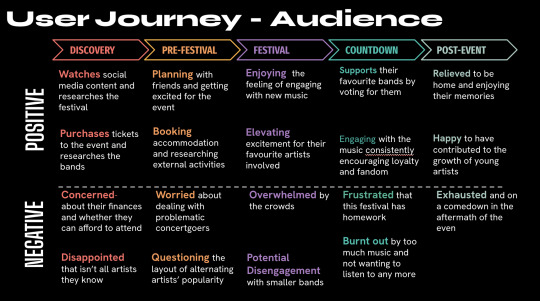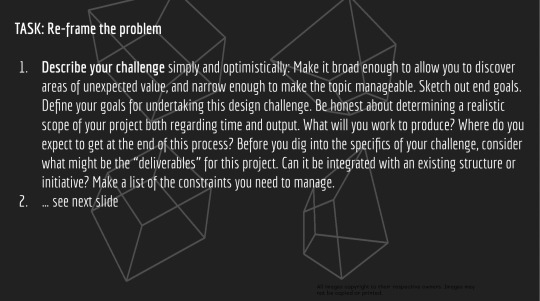Don't wanna be here? Send us removal request.
Text
Week 12
For week 12, we had presentations!! Finally, all our hard work put to work. If you want to view our presentation, here's the slides.
For my part of the presentation, I mainly worked on the promotional videos and the empathy map.
Promotional video - artist
Empathy map:
0 notes
Text
Week 11
For week 11, we did road mapping. I was a bit confused as to what was going on here, so I just prepared for assessment 2. I found DESN2002 honestly fun, but challenging until the last couple of weeks.
0 notes
Text
Week 10
This week we did user journey maps and persona's. Byron mostly did both of those. We had to do a user journey and persona for the artists that are coming to Homegrown Hitlist (since there is an artists workshop the first two days) and then one for the audience (someone going to the festival).
User journey artist:

User journey audience:

Artist persona:

Audience persona:

0 notes
Text
Week 9
For week 9, we worked on the 'rose, buds and thorns', which is a design thinking method that involves brainstorming and evaluating ideas by considering their positive aspects, potential for growth, and potential challenges, (Canvas Login | Instructure, 2025). The roses are the positive aspects of the idea, the buds represent growth and the thorns are the challenges or obstacles. I could definitely relate that to the empathy map. There's a lot of things to consider in an empathy map, such as the pain points and the good points.
In class we mainly worked on our own little bits. I was working on the empathy map and promotional video. Here's an early stage of the promotional video:
0 notes
Text
Week 8
"One of the best ways to gain insights in a Design Thinking process is to carry out some form of prototyping. This method involves producing an early, inexpensive, and scaled down version of the product in order to reveal any problems with the current design. Prototyping offers designers the opportunity to bring their ideas to life, test the practicability of the current design, and to potentially investigate how a sample of users think and feel about a product" (Dam & Siang, 2018).
A prototype is basically a model (it can be anything) that helps the creator connect with the user
This week, some of our group members worked on the prototype. Here's an early stage prototype:



References:
Dam, R., & Siang, T. (2018, November 30). Stage 4 in the Design Thinking Process: Prototype. The Interaction Design Foundation; The Interaction Design Foundation. https://www.interaction-design.org/literature/article/stage-4-in-the-design-thinking-process-prototype
0 notes
Text
Week 6
For week 6, we did presentations. For my part of the presentation, I did the user journey and empathy map.
Here's the user journey:

It wasn't the best, since there was some issues with communication and I was told I had to do it the morning of. I really didn't like that. After all of that, two of the girls made a new user journey.

Although it looks better, I think the lack of communication was ineffective.
They also changed my empathy map, to this:

Although once again, it looks good, I wish they didn't change it last minute and considered people's emotions a bit more. That's what collaboration is, right?
"On April 8, Amsterdam city council adopted a five-year circular economy strategy. This strategy includes many measures that businesses, the municipality, and also citizens will have to put in place in the coming years. For example, circular consumer goods – such as furniture, electronics, paint, and textiles – must become more available to locals," (Schouten, 2020). I think if we applied this mentality to our group project, it would be a lot more productive.
References:
Schouten, M. (2020, October 15). The Doughnut Model for a Fairer, Greener Amsterdam. Green European Journal. https://www.greeneuropeanjournal.eu/the-doughnut-model-for-a-fairer-greener-amsterdam/
0 notes
Text
Week 5
"Blockchain is solving some of the major problems currently plaguing the music industry. With blockchain, musicians are able to receive equitable royalty payments, venues are able to curb counterfeit tickets and record companies can easily trace music streams and instantly pay all artists who contributed to songs or albums," (Daley, 2019). In this article, it talks about platforms that make local musicians thrive. Which is something that we were working on for our second assessment.
For this week, we did user journeys. This was part of the 'empathise' part of the course, which mean't it followed on from the empathy map in that you have to empathise with the user.
"A user or customer journey, sometimes visualised as a journey map, is the path a person follows as they discover a product, service, or brand, learn about it, consider spending money on it, and then make a decision to purchase—or not. Not every user journey ends in a conversion, but it is typically the goal," (What Is the User Journey? [Definition + Examples], n.d.). So yeah we worked on that.
References:
Daley, S. (2019, March 16). Canvas Login | Instructure. Newcastle.edu.au. https://canvas.newcastle.edu.au/courses/31299/pages/week-5?module_item_id=1525836
What is the User Journey? [Definition + Examples]. (n.d.). Mailchimp. https://mailchimp.com/resources/user-journey/
0 notes
Text
Week 4
For week 4, we did empathy maps, which allowed us to empathise with the user. We chose 'Janice' as our artist user, who often feels burnt out, says they want to make it in the industry (but can't), thinks 'I wish I could streamline my focus and often plays at small gigs, often for little to no pay. This is the typical musician, and part of our wicked problem, that we will solve in the weeks to come...

0 notes
Text
Week 3
"If I think about the value that Design Thinking can bring to the world, I think it’s primarily about learning. In essence, Design Thinking is a different way to learn, a different learning strategy" (Hambeukers, 2024).
For week 3, we mapped out what we were going to do and looked into our prototype a bit. For our task we had to reframe the problem.


From that, we created a sheet that looked a bit like this

And filled it in accordingly.
Hambeukers, D. (2024). Canvas Login | Instructure. Newcastle.edu.au. https://canvas.newcastle.edu.au/courses/31299/pages/week-3?module_item_id=1525834
0 notes
Text
Week 2
So what is a wicked problem?
“Wicked problems are problems with many interdependent factors making them seem impossible to solve. Because the factors are often incomplete, in flux, and difficult to define, solving wicked problems requires a deep understanding of the stakeholders involved, and an innovative approach provided by design thinking.” (Interaction Design Foundation - IxDF. (2016)
For this week, we looked at the design thinking process. First to empathise, doing things such as interviews or shadowing, second to define, such as using personas, role objectives or decisions. Third is to ideate, which is to share ideas, prioritise what needs to be done. Fourth is the prototype, which we worked on mostly in class, which you can do by creating mock ups, storyboards and by keeping it simple. Last is to test. This is by understanding the impediments, what works and role playing.

In class we focused on team building, and introducing ourselves to our team members. There was a mixture of VISCOM, education and music students in our group, and we decided on 'how to thrive in the music industry as our wicked problem.
References:
Interaction Design Foundation - IxDF. (2016, June 4). What are Wicked Problems?. Interaction Design Foundation - IxDF. https://www.interaction-design.org/literature/topics/wicked- problems
0 notes
Text
Week 1
“Design thinking is a human-centered approach to innovation that draws from the designer’s toolkit to integrate the needs of people, the possibilities of technology, and the requirements for business success.” (IDEO, 2024)
In week one, we learn't about design thinking. In this we discussed wicked problems, which is about discovering a 'wicked problem' and solving it. An example, which was in our tutorials was to draw how to make a piece of toast and solve it. That's mainly what we will be working on the entire semester and in our project.
#uni #uniassignment
1 note
·
View note